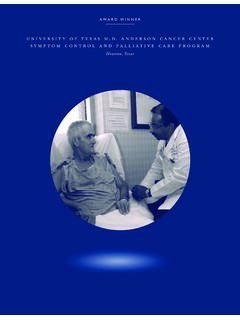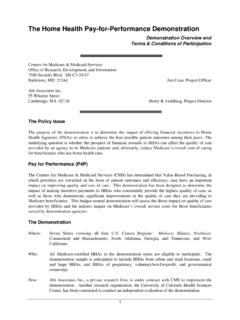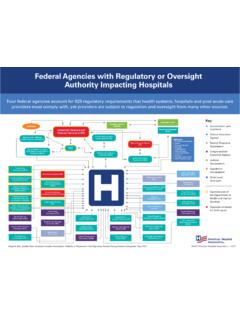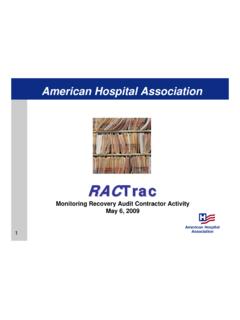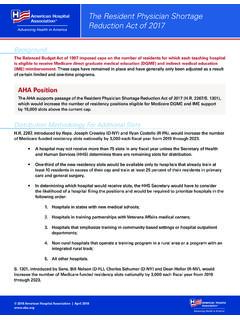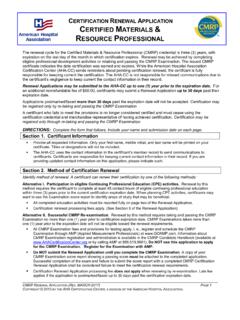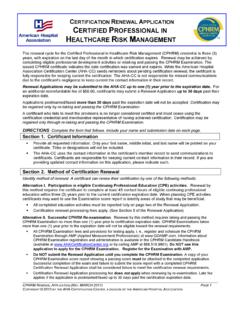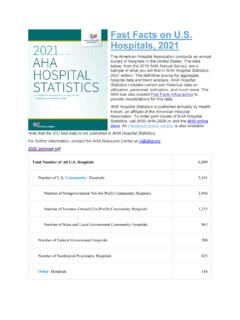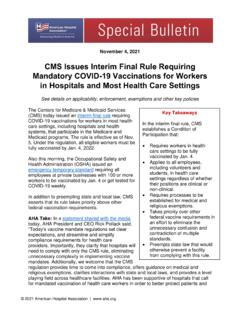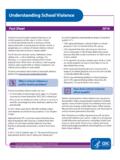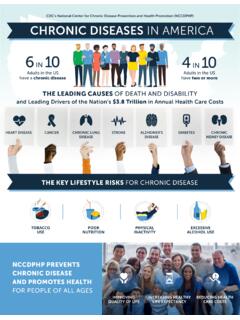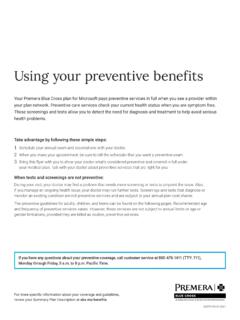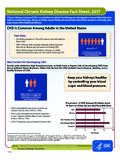Transcription of FACT SHEET Federally Qualified Health Center
1 Federally Qualified Health Center FACT SHEET1 FACTSHEETF ederally Qualified Health Center Th e Fe d e r a l l y Qu a l iF i e d he a l t h Ce n t e r (FQhC) benefit under Medicare was added effective October 1, 1991 when Section 1861(aa) of the Social Security Act (the Act) was amended by Section 4161 of the Omnibus Budget Reconciliation Act of 1990. FQHCs are safety net providers such as community Health centers, public housing centers, outpatient Health programs funded by the Indian Health Service, and programs serving migrants and the homeless. The main purpose of the FQHC Program is to enhance the provision of primary care services in underserved urban and rural communities.
2 Federally Qualified Health Center DesignationAn entity may qualify as an FQHC if it: n Is receiving a grant under Section 330 of the Public Health Service (PHS) Act; n Is receiving funding from such grant under a contract with the recipient of a grant and meets the requirements to receive a grant under Section 330 of the PHS Act; n Is not receiving a grant under Section 330 of the PHS Act but determined by the Secretary of the Department of Health and Human Services (HHS) to meet the requirements for receiving such a grant ( , qualifies as a FQHC look-alike) based on the recommenda- tion of the Health Resources and Services Administration; n Was treated by the Secretary of the Depart- ment of HHS for purposes of Medicare Part B as a comprehensive Federally funded Health Center as of January 1, 1990.
3 Or n Is operating as an outpatient Health pro-gram or facility of a tribe or tribal organiza-tion under the Indian Self-Determination Act or as an urban Indian organization receiving funds under Title V of the Indian Health Care Improvement Act as of October 1, Federally Qualified Health Center Services Payments are made directly to the FQHC for covered services furnished to Medicare benefi-ciaries. Services are covered when furnished to a beneficiary at the FQHC, the beneficiary s place of residence, or elsewhere ( , at the scene of an accident). A FQHC generally furnishes the following services:n Physician services;n Services and supplies incident to the services of physicians;n Nurse practitioner (NP), physician assistant (PA), certified nurse midwife (CNM), clinical psychologist (CP), and clinical social worker (CSW) services;n Services and supplies incident to the services of NPs, PAs, CNMs, CPs, and CSWs;n Visiting nurse services to the homebound in an area where the Centers for Medicare & Medicaid Services (CMS) has determined that there is a shortage of Home Health Agencies.
4 N Otherwise covered drugs that are furnished by, and incident to, services of a FQHC provider; andn Outpatient diabetes self-management training and medical nutrition therapy for beneficiaries with diabetes or renal disease (effective for services furnished on or after January 1, 2006).FQHCs also furnish preventive primary Health services when furnished by or under the direct supervision of a physician, NP, PA, CNM, CP, or CSW. The following preventive primary Health services are covered when furnished by FQHCs to Medicare beneficiaries:n Medical social services;n Nutritional assessment and referral;n preventive Health education;n Children s eye and ear examinations;n Well child care including periodic screening;n Immunizations including tetanus-diphtheria booster and influenza vaccine;n Voluntary family planning services;n Taking patient history;n Blood pressure measurement;n Weight measurement;n Physical examination targeted to risk;n Visual acuity screening;n Hearing screening;n Cholesterol screening.
5 N Stool testing for occult blood;n Tuberculosis testing for high risk beneficiaries;n Dipstick urinalysis; andn Risk assessment and initial counseling regarding women only:n Prenatal and post-partum care;n Prenatal services;n Clinical breast examination;n Referral for mammography; and n Thyroid function Qualified Health Center preventive Primary Services that are NOT CoveredFQHC preventive primary services that are NOT covered include:n Group or mass information programs, Health education classes, or group education activities including media productions and publications; andn Eyeglasses, hearing aids, and preventive dental or services that are covered under Part B, but are NOT FQHC services include:n Certain laboratory services;n Durable medical equipment, whether rented or sold, including crutches, hospital beds, and wheelchairs used in the beneficiary s place of residence;n Ambulance services;n The technical component of diagnostic tests such as x-rays and electrocardiograms;n The technical component of the following preventive services: Screening pap smears; Prostate cancer screening; Colorectal cancer screening tests; Screening mammography.
6 And Bone mass measurements;n Prosthetic devices that replace all or part of an internal body organ including colostomy bags, supplies directly related to colostomy care, and the replacement of such devices; andn Leg, arm, back, and neck braces and artificial legs, arms, and eyes including replacements (if required because of a change in the beneficiary s physical condition). Federally Qualified Health Center PaymentsGenerally, Medicare pays FQHCs (which are considered suppliers of Medicare services) an all-inclusive per visit Federally Qualified Health Center FACT SHEET2payment amount based on reasonable costs as reported on its annual cost report.
7 The beneficiary pays no Part B deductible for FQHC services but is responsible for paying the coinsurance with the exception of FQHC-supplied influenza and pneumococcal vaccines, which are paid at 100 percent. The coinsurance for FQHC services is 20 percent of the clinic s reasonable and customary billed charges except for mental Health treatment services, which are subject to the percent outpatient mental Health treatment limitation. The application of the outpatient mental Health treatment limitation increases the beneficiary s copayment to 50 percent of the clinic s reasonable and customary billed charges. This limit does not apply to diagnostic services.
8 With enactment of the Medicare Improvements for Patients and Providers Act of 2008, the amount of this limitation will be reduced incrementally over the next five years beginning with services provided on or after January 1, 2010. The FQHC all-inclusive visit rate is calculated, in general, by dividing the FQHC s total allowable cost by the total number of visits for all FQHC patients. The FQHC payment methodology includes two national per-visit upper payment limits one for urban FQHCs and one for rural FQHCs. The two national FQHC per-visit upper payment limits are increased annually by the Medicare Economic Index applicable to primary care physician services.
9 A FQHC is designated as an urban or rural entity based on definitions in Section 1886(d)(2)(D) of the Act. If a FQHC is not located within a Metropolitan Statistical Area (now generally known as a Core Based Statistical Area) or New England County Metropolitan Area, it is considered rural and the rural limit applies. Rural FQHCs cannot be reclassified into an urban area for FQHC payment limit FQHCs must complete Form CMS-222-92, Independent Rural Health Clinic and Freestanding Federally Qualified Health Center Cost Report, in order to identify all incurred costs applicable to furnishing covered FQHC services. Form CMS-222-92 can be found in the Provider Reimbursement Manual Part 2 (Pub.)
10 15-2), Chapter 29, located at on the CMS website. Provider-based FQHCs must complete the appropriate worksheet designated for FQHC services within the parent provider s cost report. For example, FQHCs based in a hospital complete Worksheet M of Form CMS-2552-96, Hospital and Hospital Complex Cost Report. At the beginning of the FQHC s fiscal year, the Fiscal Intermediary or A/B Medicare Administrative Contractor calculates an interim all-inclusive visit rate based on either estimated allowable costs and visits from the FQHC (if it is new to the FQHC Program) or on actual costs and visits from the previous cost reporting period (for existing FQHCs).
